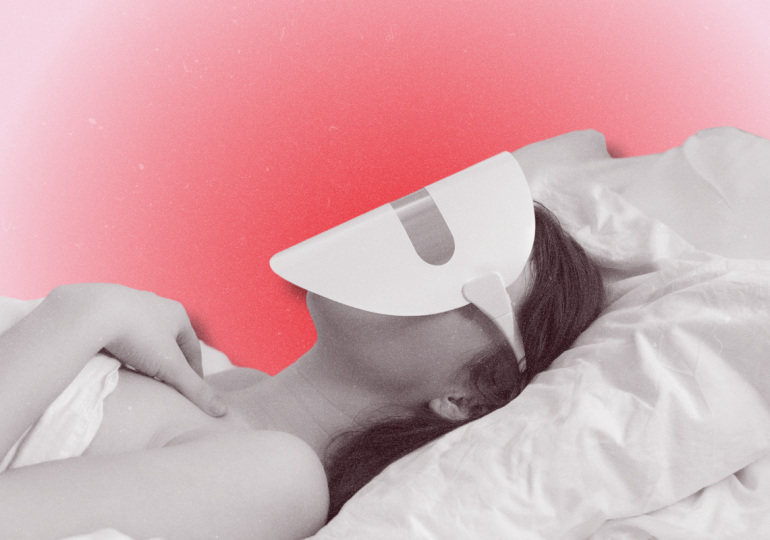If you’re always on the lookout for the latest skincare gadget, you may have already tried facial rollers, sculpting wands, and dermaplaning devices. And you may be curious about the red-glowing masks that you’ve seen making the rounds on social media.
Red-light masks use low levels of light-emitting diode, or LED, to stimulate skin cells, says Dr. Jennifer Sawaya, a dermatologist at U.S. Dermatology Partners Scottsdale in Arizona. “Red light is a type of visible light that has been clinically shown to rejuvenate the skin.”
[time-brightcove not-tgx=”true”]
Instagrammers and TikTokkers claim the masks—which, face it, do make you look like a character from a sci-fi film—can minimize wrinkles, smooth your complexion, and even improve acne. But these masks can be pricey, costing anywhere from $100 to thousands of dollars, and similar but stronger treatments are available at spas and dermatologists’ offices.
So, do at-home red light masks actually work? Sawaya says studies have shown red-light therapy can benefit the skin, but seeing results depends on using the devices regularly. Here’s what you should know about red-light masks.
What can red-light masks do for your skin?
Red-light therapy has been used for decades in a variety of treatments. NASA first began using it to boost plant growth in space in the 1990s and then to speed up wound healing. The light’s ability to penetrate the skin was shown to help promote collagen and tissue growth.
It’s also used in photodynamic therapy, which utilizes low-power red laser light to drive a cell-destroying chemical reaction that can treat conditions like skin and other types of cancer, psoriasis, acne, and warts, according to the Cleveland Clinic.
As an anti-aging treatment, low-level light therapy with red and infrared wavelengths can improve how skin cells work, explains Dr. Heather Rogers, a dermatologist at Modern Dermatology in Seattle. Cells absorb energy from the light, which makes them more efficient in using oxygen and producing the compounds cells use for fuel.
“With more fuel, the cells become more active and better at doing their jobs, including DNA repair, collagen synthesis, and calming inflammation,” she says.
Read More: How Much Do You Actually Need to Shower?
As you age, you start to lose collagen, a protein that gives your skin structure and elasticity. Sun damage can also deplete it. So boosting collagen production can make wrinkles and fine lines less apparent.
A 2019 company-sponsored study published in the Journal of the American Academy of Dermatology suggested that low-level red and infrared light stimulate biomarkers that are linked to anti-aging skin benefits, and daily at-home treatments could improve the signs of early aging and sun damage.
In other words, red light can help “rejuvenate” your complexion, Sawaya says. “Specifically, studies have shown that red-light therapy can reduce the appearance of wrinkles, pigmentation, broken blood vessels, and improve the skin’s elasticity and hydration.”
Red light isn’t the only color of visible light that can benefit the skin.
Another company-sponsored study published in the Journal of the American Academy of Dermatology in 2018 found that red- and blue-light therapy could help treat mild to moderate acne. The research suggested that blue light may reduce acne-causing bacteria on the skin, while red light minimized inflammation. Sawaya says blue light may also decrease the activity of oil glands, which encourages acne.
Blue light may also help treat mild psoriasis, according to the American Academy of Dermatology.
How to get the best results from an at-home red light mask
It can take time to see results from red-light therapy, and it may not work for everyone, says Dr. David Kim, a dermatologist at Idriss Dermatology in New York City. He recommends consistently using a red-light mask three to five times a week for at least a couple of months if you’re interested in minimizing the signs of acne, treating acne, or smoothing your complexion.
“Figure out your habit and stick to it,” suggests Rogers, who wears a red-light mask before her morning skincare routine and before bedtime.
Read More: What’s the Best Skin-Care Routine?
The masks are most effective when used on clean, dry skin so the light can be well absorbed by the skin, Sawaya says. Sometimes, the masks can dry out your skin, so Rogers suggests moisturizing afterward.
When purchasing a red-light mask, make sure the product has been cleared by the U.S. Food and Drug Administration (FDA), which classifies medical devices, including light therapy masks, into different categories, and follow the manufacturer’s directions, Sawaya adds. Most products state whether they’re FDA-cleared. You should use the mask for only the time recommended; most brands suggest using products for about 10 minutes at a time.
For skin improvements, the ideal wavelength for red light is about 640 nanometers and about 830 nanometers for infrared light, Rogers says.
How at-home masks differ from in-office versions
At-home red light masks can be beneficial, but Kim says they’re not as “robust” as the LED therapy offered in dermatologists’ offices or spas.
“At-home red and blue light LED masks use much lower energy levels than what you would expect in an in-office treatment,” Sawaya explains, so you likely need to use them daily to see results.
Still, at-home versions can complement in-office light treatments, Rogers says, adding that if you use your mask at home—while also taking good care of your skin by moisturizing and diligently wearing sunscreen—you may need fewer in-office treatments.
There are several red-light masks available. Rogers says her favorites are by Celluma and Omnilux, and she suggests choosing a full-face mask or ones with larger panels instead of handheld wands for more uniform treatment.
“For best outcomes, the device needs to be touching or nearly touching your skin to ensure the energy is being absorbed into your skin,” she explains.
Are red light masks safe?
At-home LED masks are generally safe for most people, as they use relatively low levels of energy, Sawaya says.
However, if you have sensitive skin or are sensitive to light, you should avoid the masks unless your doctor gives you the OK, she notes.
Read More: 5 Dermatologists on the 1 Thing You Should Do Every Day
Light therapy can also worsen melasma, a condition that causes blotches to form on the skin, Rogers says. Visible light, including red and blue, might also worsen hyperpigmentation or melasma for people with darker skin tones, Kim adds.
If you’re using a red-light mask daily and not getting the anti-aging results you’re hoping for, or you’ve noticed dryness, pigmentation shifts, or other skin changes, Kim suggests seeing a dermatologist. Doctors can recommend the best treatments based on your skin type and individual needs.
Leave a comment









